Uma Casa de Sangue is an exploration of natural and supernatural architecture, centered around the mystery of a real-world bleeding house.
In part II, we examine the many substances that are said to appear from walls, and the story in Jardim Bizarro takes a strange turn.
This article contains photos of blood; use discretion when viewing.
In the realm of fiction, the various phenomena that mark a haunted house are usually signifiers of some sort – a bleeding wall is a tool used by the author to communicates something about the nature of the haunting.
Real life is rarely defined by these narrative devices. In the house at Jardim Bizarro, as elsewhere, we cannot trust that the mysterious phenomena we encounter have conscious intent and meaning behind them. In real life it is much more useful to ask “what is the house bleeding?” than “why is the house bleeding?”
This is partly because the real life bleeding house is a very rare phenomenon. But it is also because that houses frequently weep, seep, exude, ooze and manifest any number of liquids beyond blood, all of which carry their own stories and explanations, natural and otherwise.
The most banal of the lot is water, usually marking a building failure of some sort, a roof leak or a busted pipe leading to swollen ceiling tiles, flooding wall cavities, water flowing from outlets, and quietly rotting structures. There are considerable consequences to a water leak, but it is hardly mysterious.
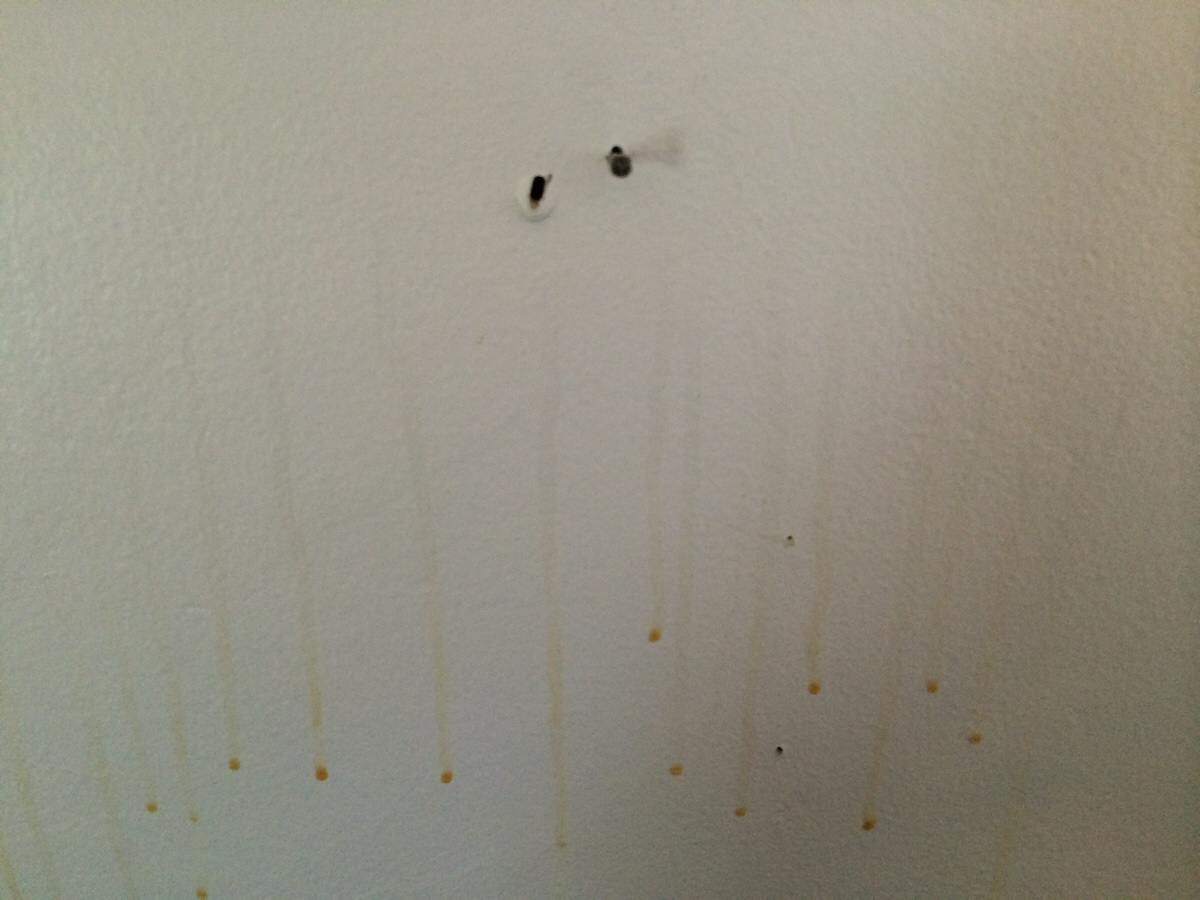
Possible surfactant leaching. Image from this Reddit discussion.
Depending on heat and humidity, it is possible for softwoods to begin exuding resin; if paint is applied during a period of cool temperatures, subsequent resin bleed can begin look very much like your wall, door frame, or wood structure desperately needs medical attention. It is also possible for certain paints to undergo a process called surfactant leaching, in which water-soluble paint ingredients can begin to coalesce on the surface of a wall, causing translucent or reddish-brown droplets to flow from nowhere at all.
The most peculiar of the natural substances to flow from the walls of your home would be honey. Large infestations of bees – we’re talking in the scale of thousands and thousands of them – have caused honey to drip down walls, even after the bees themselves have been exterminated.

As described. Image from Fox 15 Abilene.
But we’ve been limiting ourselves to the explicable. If we decide to delve into the supernatural substances that, it is claimed, have manifested on the surface of walls, we generally find ourselves talking about three substances: water, oils, and of course blood, all of which have well-defined narratives behind them.
If this begins to sound unlikely or implausible, remember that we’re only trying to engage with the stories that people tell, and the phenomena that people believe they have experienced.
Water
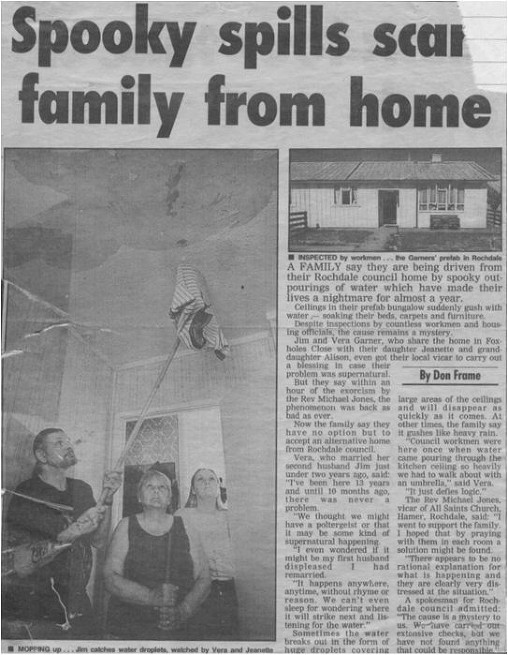
The Rochdale Poltergeist. Image via.
The spontaneous appearance of water is generally associated with poltergeists – which is to say, the type of ghost that throws objects, knocks on walls, and causes mischief. In a handful of cases, such as the Enfield Poltergeist, puddles of water were seen to manifest directly on the floor. During the alleged Rochdale Poltergeist, water would condense and drop from the ceilings of a prefab home that had no pipes there. This brief article describes a Polish poltergeist that created “a frequent and sudden gushing of water and other not identified liquids from the ceiling, walls, door bays, and furniture. Water splashed out of glasses, pots, and other containers, besprinkling the family members or whoever was present at that time.“
In these examples water is a neutral substance that is only notable for its peculiar behaviour – usually quite mischievous. When water appears under mysterious or supernatural circumstances, it is almost always described as manifesting within the physical bounds of the room, rather than, say, bleeding through the wall. The ceilings in Rochdale, after all, would be totally dry moments after “raindrops” fell from above.
Oil

Miraculous Oil. Image via Daily Mail.
I’m not talking about crude – that’s a different problem altogether – but instead scented anointing oil, which seeps from walls in miraculous, religious contexts. Unlike water, which manifests within the confines of a space, oil usually manifests directly on the surface of the house itself.
This is uncommon; in the realm of miracles, holy statues and icons weeping or manifesting oil are a much broader tradition. Nevertheless, I have found several specific examples: a suburban home in Australia following the death of a family member, a personal residence in California, an apartment in Surrey, British Columbia, and the home of Audrey Santo in Massachusetts. In all cases, the appearance of oil on either walls or artifacts serves to mark the site of an alleged holy event.
It is worth recognizing is the specific utility of this oil in a religious context. Miraculous and holy oil sourced from a holy site carries power. Stories of the miraculous appearance of oil are often paired with stories of miraculous healing.
This holy phenomenon is not without controversy. Most of these scenarios have played out in the homes of those of Orthodox Christian or Catholic faith. I’ve noticed that the Greek Orthodox Church tends to be a little more flexible in the official endorsement of miracles than the Vatican, which tends to be institutionally thrifty with the official designations of “miracle.” They prefer to leave the Sacrament of the Anointing of the Sick to priests and bishops. As such, I’m not aware of any Vatican-recognized miracles of oil weeping from walls.
It is also worth recognizing that statues and icons weeping are not limited to oil: tears and blood also have been observed. However, a statue that bleeds is a distinctly holy event; walls bleeding are hardly a marker of holiness, as we shall see.
Blood
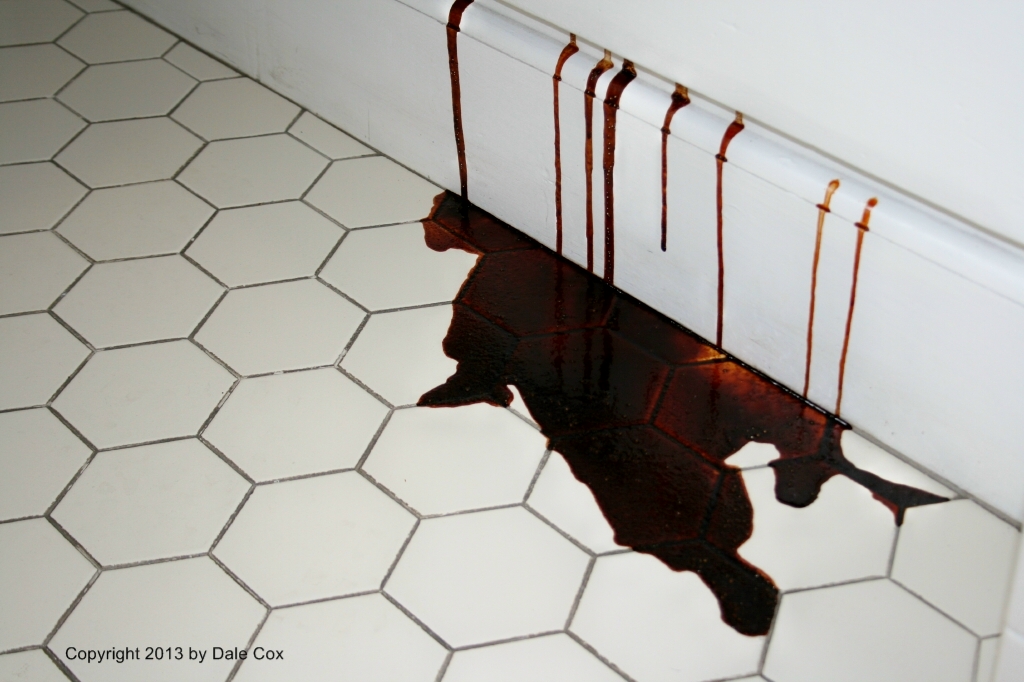
Copyright 2013 by Dale Cox. Probably not blood. Probably.
Blood is corporeal. Blood isn’t like water or oil, with ambiguous or neutral origin. Blood comes from bodies. The idea of a bleeding wall suggests a body, with the blood emerging from within.
There are very few accounts of real-world bleeding homes.I did find three examples, and the common points between these houses are worth noting: every one of these homes is in the United States, each of the hauntings occurred in the 1980s or more recently, and each haunting received a considerable amount of public attention when it occurred, from paranormal investigators and the media. Most important, however, is that all of these hauntings are… peculiar.
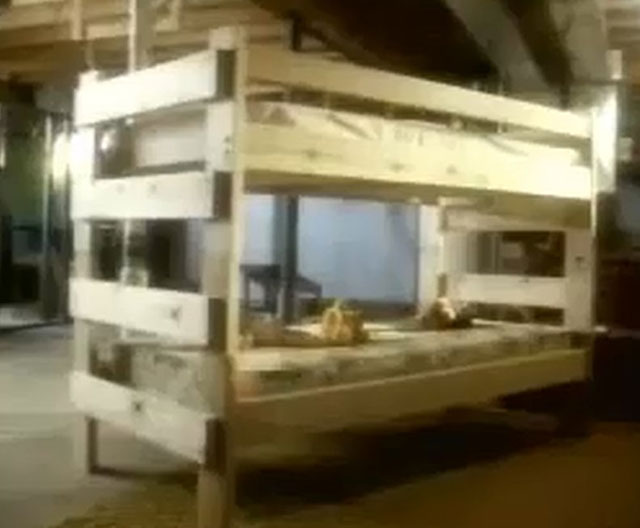
The bunk bed was alleged by some to be the source of the Tallmann House haunting. This still is from Unsolved Mysteries.
For instance, we have the Tallmann House in Horicon, Wisconsin, a conventional tract house which allegedly became haunted in 1987 when family members bought a used bunk bed. Sightings were fairly standard at first: the appearance of an old hag, radios changing stations, but they escalated. Members of the family received demonic death threats from beings consisting of flame with green eyes. A snowblower was reported to clear the driveway by itself. Once the family abandoned the home, rumour spread of a portal to hell in the basement. And, yes, the ceiling and walls bled.
Another example from the 1980s is the San Pedro, Los Angeles haunting of Jackie Hernandez. An LA Times article from 1993 describes the poltergeist activity centered around Ms. Hernandez as a remarkable collection of allegedly well-documented phenomena. For our purposes, I’d like to call your attention to the line that mentions in passing a “stinking blood-like liquid that oozed from the walls.”

Male blood plasma, or “blood-like fluid?” from Ghost Theory.
Depending on where your source your information, this minor detail can change. The Occult Museum describes this liquid as “a strange liquid […] (later believed to be blood plasma)” Meanwhile via our best source for theories about ghosts, a.k.a. GhostTheory.com, an article about the Hernandez haunting (based on a documentary produced by one of the investigators) assures us that not only was the substance weeping from the cabinetry proven to be blood plasma, but it was male blood plasma, with very high levels of iodine and copper!
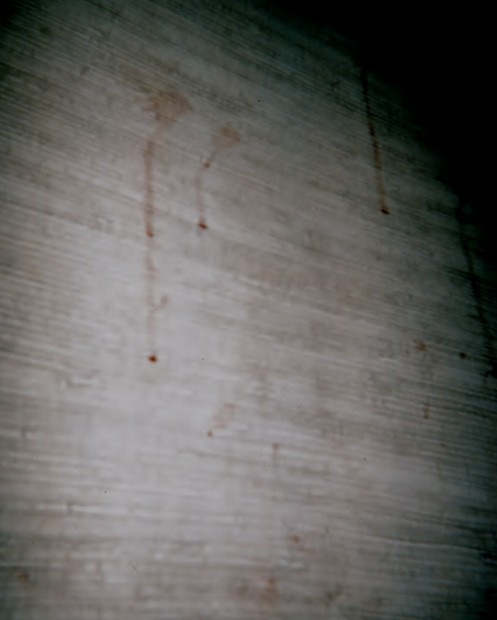
From the Brownville case. Photo by Bob Cranmer via The Blaze.
A final case, the Demon of Brownsville Road, was an entity which allegedly stole objects, bent crucifixes, and sprinkled a “blood-like substance” throughout the home. This home was cleansed of its demonic occupation thanks to the Catholic Diocese of Pittsburgh, who officially stand by this story as an example of authentic demonic oppression. The owner of the home, Bob Cranmer, laments that while the presence is gone they will likely be unable to sell the home due to its terrible reputation. For more information on this haunting take a look on the home’s official website The Demon of Brownsville Road, the Wikipedia article, or purchase the official book, co-written by Bob Cranmer and Erica Manfred, on Amazon.
So, what are we to make of blood that seeps from walls?
Without questioning the veracity of these cases, I would like to point out the apparent value that the bleeding wall has as being shorthand for a remarkable evil embodied within a house.
I cannot shake the similarity between these images and a scene in the 1979 film The Amityville Horror, in which an extremely haunted house begins to bleed during a moment of, shall we say, great emotional stress.
The Amityville Horror is notorious; the film based on the book based on a “true story” now acknowledged to have been invented, whole-cloth, by the Lutz family and a lawyer, William Weber. In the original book about their experiences, it was not blood but a mysterious green slime that oozed from the walls.
Nonetheless, the cultural impact of the film likely can’t be denied, coming to light in the years up to several of the hauntings noted above. I suspect that this particular moment in pop culture, possibly alongside the blood elevators in The Shining, is the origin of the shorthand that is the bleeding wall, a symbol for a place so steeped in evil intent, so full thing from beyond the veil, that it gains some form of life of its own. This is the pop culture imagery that hangs overhead when we see a historic, allegedly haunted home seeping blood-ish fluid, like the employees of the Russ House in Florida witnessed in 2013.
This, I think, is what the bleeding wall means to us.
And yet – this isn’t what we see at the house in Jardim Bizarro. This is a bit of a relief; if the story in this house fails to follow the fictional or real-world conventions of peculiar phenomena, unlike the stories above, we may have a better chance of seeing it explained.
The second article to appear about the matter, several days after the first, was a minor update, but it unveiled a small number of interesting details.
One, there was some clarification about the location of the blood. While some of it had run down the walls to the floor, it appeared that it had not emerged straight from the wall, of course. Instead it had been sprayed… upwards, from the floor. In fact, most of the blood had been found along the floor; the notion that it had been bled from the walls appeared to be the result of the aforementioned cultural imagination when the narrative translated from the police to reporters and onto paper.
Two, the husband pointed out a pattern he had noticed: “When I shower, nothing happens,” he told reporters. “When my wife showers, it starts.” Apart from the first few days, however, the event had not repeated.
Three, the owners of the house steadfastly remained anonymous, never attempting to gain publicity or notoriety from their circumstances. A prayer group came in to potentially help the situation, but the couple simultaneously remained realistic about the circumstances. The wife was willing to believe that the blood had even been sprayed maliciously by someone unknown. All of this, in my experience, is atypical behaviour for a hypothetical religious or paranormal hoaxer.
Four, the blood was very fresh, as in, it must have appeared the same day it was removed from a body. And it did come directly from a body: the fact that the blood had coagulated meant it couldn’t have, for instance, been stolen from a blood bank, where anticoagulants are added as a matter of course. It had come from someone.
The police had taken DNA samples from the couple, as well as their daughter, to try to rule them out as a source. Things are rarely that easy.
Someone leaked images of the house, and we discover that what we’re dealing with is not so much Amityville as it is The Shining. Or maybe Saw.


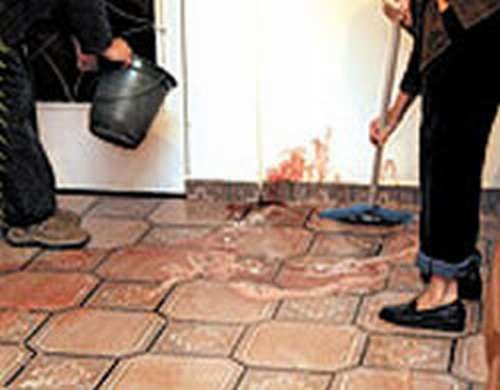
Shortly after, the police announced the results of the DNA test: the blood was the wife’s. By this point, however, they’d already figured that out.
And that’s where things get weird.
To be concluded in pt. III.
Sean Maciel is a graduate of UWSA.




Leave a Reply